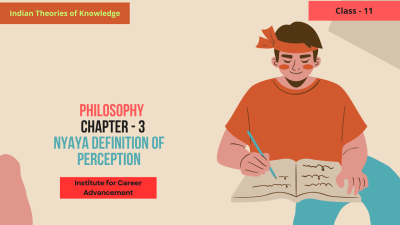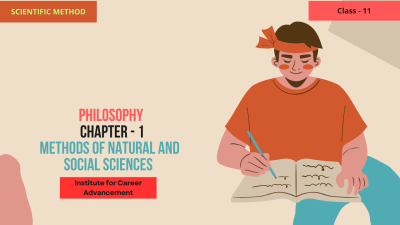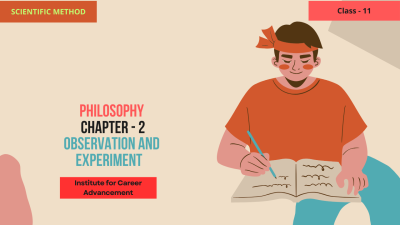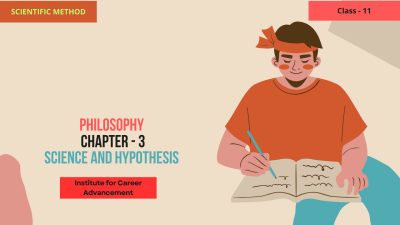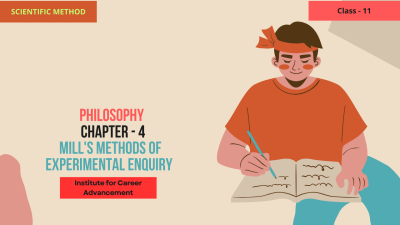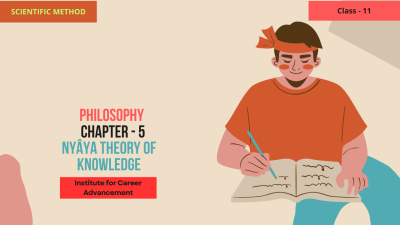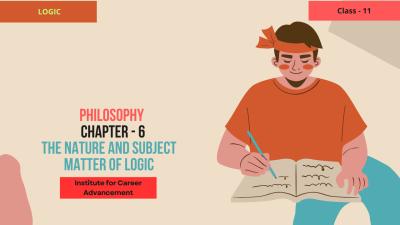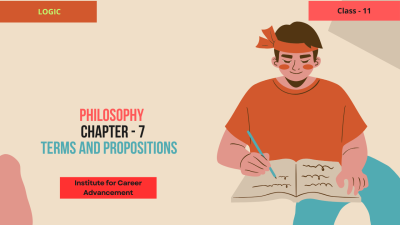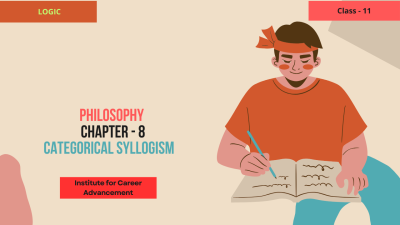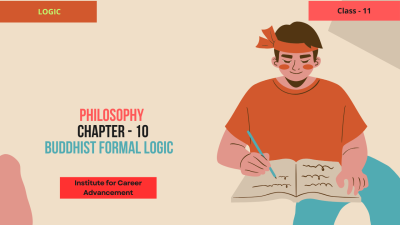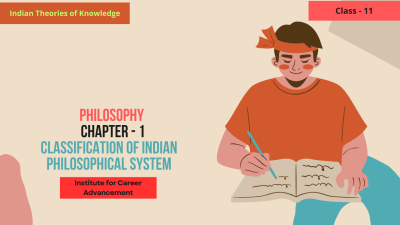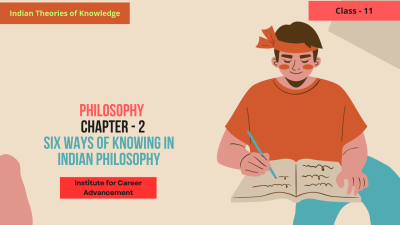Course description
The Nyaya school of philosophy, one of the six classical schools of Indian philosophy, places a strong emphasis on logic, reasoning, and epistemology (the study of knowledge). In the context of Class 11 philosophy, when studying the Nyaya definition of Perception, students are introduced to the classical epistemological framework in which perception is a central means of gaining valid knowledge (pramana).
Here’s an overview of the Nyaya definition of Perception for a Class 11 course:
Nyaya School of Philosophy: An Introduction
The Nyaya school is particularly known for its rigorous approach to logic, debate, and the nature of knowledge. It considers pratyaksha (perception) as one of the primary sources of valid knowledge. In Nyaya, perception is essential in establishing truth and is foundational to understanding the world.
Definition of Perception in Nyaya Philosophy:
In Nyaya philosophy, perception (Pratyaksha) is considered a direct means of acquiring knowledge. It is defined as the knowledge that arises from the direct experience of an object through the senses, without the need for any intermediary process like reasoning or inference.
According to Nyaya, perception is unmediated and immediate, which means that it occurs directly when the senses come into contact with an object or phenomenon. Nyaya holds that perception must be valid and true, meaning it leads to the correct understanding of the world.
Characteristics of Perception (Pratyaksha) in Nyaya:
The Nyaya school identifies two main types of perception:
External Perception (Bahir-Pratyaksha):
Definition: Knowledge gained from the external senses (e.g., sight, hearing, touch, taste, and smell) when we interact with the external world.
Example: Seeing a tree, hearing the sound of a bell, feeling heat from the sun.
Internal Perception (Antar-Pratyaksha):
Definition: Knowledge derived from the mind, not through external senses, but through the internal faculties of consciousness. This includes self-awareness and emotional experiences.
Example: Feeling hungry, experiencing pain, or thinking about something.
Nyaya's Criteria for Valid Perception:
For perception to be valid (a source of true knowledge), Nyaya provides certain criteria:
Direct Contact (Sannikarsa): There must be direct contact between the object and the sense organ for knowledge to be considered valid.
Unmediated Knowledge: The knowledge gained through perception should be immediate and not require any inference or reasoning.
True: The perception must correctly represent the object in question. This means that perception must not be distorted or confused by external factors (e.g., illusions).
Non-Contradiction: The knowledge obtained through perception must not contradict other forms of valid knowledge.
Perception and the Four Conditions in Nyaya:
Nyaya philosophers also define four conditions necessary for perception:
Cognition of an object (Artha): There must be a real object or phenomenon to be perceived.
Contact with the senses (Samsparsha): The object must come into direct contact with the sense organs (like the eyes, ears, skin, etc.).
Sense organ activity (Indriya): The sense organs must be functioning properly to acquire knowledge.
Cognition of the object (Jñāna): There must be a mental process that acknowledges the knowledge gained from the senses.
Conclusion:
The Nyaya school provides a structured and logical framework for understanding perception as a source of knowledge. In Class 11, studying the Nyaya definition of perception allows students to appreciate the precision and importance that Indian philosophers placed on direct sensory experience and how it forms the foundation of valid knowledge in the Indian philosophical tradition.
ভারতীয় দর্শনের ছয়টি ধ্রুপদী ধারার মধ্যে একটি, দর্শনের ন্যায় ধারা যুক্তি, যুক্তি এবং জ্ঞানতত্ত্বের (জ্ঞান অধ্যয়ন) উপর জোর দেয়। একাদশ শ্রেণির দর্শনের প্রসঙ্গে, উপলব্ধির ন্যায় সংজ্ঞা অধ্যয়ন করার সময়, শিক্ষার্থীদের শাস্ত্রীয় জ্ঞানতাত্ত্বিক কাঠামোর সাথে পরিচয় করিয়ে দেওয়া হয় যেখানে উপলব্ধি বৈধ জ্ঞান অর্জনের একটি কেন্দ্রীয় মাধ্যম (প্রমাণ)। এখানে একাদশ শ্রেণির কোর্সের জন্য উপলব্ধির ন্যায় সংজ্ঞার একটি সংক্ষিপ্ত বিবরণ দেওয়া হলঃ ন্যায় স্কুল অফ ফিলোসফিঃ একটি ভূমিকা ন্যায় বিদ্যালয়টি যুক্তি, বিতর্ক এবং জ্ঞানের প্রকৃতির প্রতি কঠোর দৃষ্টিভঙ্গির জন্য বিশেষভাবে পরিচিত। এটি প্রত্যক্ষকে (উপলব্ধি) বৈধ জ্ঞানের অন্যতম প্রাথমিক উৎস হিসাবে বিবেচনা করে। ন্যায়ের মধ্যে, উপলব্ধি সত্য প্রতিষ্ঠার জন্য অপরিহার্য এবং বিশ্বকে বোঝার জন্য ভিত্তিগত। ন্যায় দর্শনে উপলব্ধির সংজ্ঞাঃ ন্যায় দর্শনে, উপলব্ধি (প্রত্যক্ষা) কে জ্ঞান অর্জনের প্রত্যক্ষ মাধ্যম হিসাবে বিবেচনা করা হয়। এটিকে এমন জ্ঞান হিসাবে সংজ্ঞায়িত করা হয় যা যুক্তি বা অনুমানের মতো কোনও মধ্যস্থতাকারী প্রক্রিয়ার প্রয়োজন ছাড়াই ইন্দ্রিয়ের মাধ্যমে কোনও বস্তুর সরাসরি অভিজ্ঞতা থেকে উদ্ভূত হয়। ন্যায়ের মতে, উপলব্ধি হল মধ্যস্থতাহীন এবং তাৎক্ষণিক, যার অর্থ হল ইন্দ্রিয়গুলি যখন কোনও বস্তু বা ঘটনার সংস্পর্শে আসে তখন এটি সরাসরি ঘটে। ন্যায় মনে করেন যে উপলব্ধি অবশ্যই বৈধ এবং সত্য হতে হবে, যার অর্থ এটি বিশ্বের সঠিক বোঝার দিকে পরিচালিত করে। নিয়মে উপলব্ধির (প্রত্যক্ষা) বৈশিষ্ট্যঃ ন্যায় ধারা দুটি প্রধান ধরনের উপলব্ধি চিহ্নিত করেঃ বাহ্যিক উপলব্ধি (বহির-প্রত্যক্ষা) সংজ্ঞাঃ বাহ্যিক ইন্দ্রিয় থেকে প্রাপ্ত জ্ঞান (e.g., দৃষ্টি, শ্রবণ, স্পর্শ, স্বাদ এবং গন্ধ) যখন আমরা বাহ্যিক বিশ্বের সাথে যোগাযোগ করি। উদাহরণঃ একটি গাছ দেখা, ঘণ্টার শব্দ শোনা, সূর্য থেকে উত্তাপ অনুভব করা। অভ্যন্তরীণ উপলব্ধি (অন্তর-প্রত্যক্ষা) সংজ্ঞাঃ মন থেকে প্রাপ্ত জ্ঞান, বাহ্যিক ইন্দ্রিয়ের মাধ্যমে নয়, বরং চেতনার অভ্যন্তরীণ দক্ষতার মাধ্যমে। এর মধ্যে রয়েছে আত্ম-সচেতনতা এবং আবেগগত অভিজ্ঞতা। উদাহরণস্বরূপঃ ক্ষুধার্ত বোধ করা, ব্যথা অনুভব করা বা কিছু নিয়ে চিন্তা করা। বৈধ উপলব্ধির জন্য ন্যায়ের মানদণ্ডঃ উপলব্ধি বৈধ হওয়ার জন্য (সত্য জ্ঞানের উৎস) ন্যায় নির্দিষ্ট মানদণ্ড প্রদান করেঃ প্রত্যক্ষ যোগাযোগ (সন্নিকর্ষ) জ্ঞানকে বৈধ হিসাবে বিবেচনা করার জন্য বস্তু এবং ইন্দ্রিয়ের মধ্যে অবশ্যই সরাসরি যোগাযোগ থাকতে হবে। মধ্যস্থ জ্ঞানঃ উপলব্ধির মাধ্যমে অর্জিত জ্ঞান তাৎক্ষণিক হওয়া উচিত এবং এর জন্য কোনও অনুমান বা যুক্তির প্রয়োজন নেই। সত্যঃ উপলব্ধি অবশ্যই প্রশ্নযুক্ত বস্তুটিকে সঠিকভাবে উপস্থাপন করতে হবে। এর অর্থ হ 'ল বাহ্যিক কারণগুলি দ্বারা উপলব্ধি বিকৃত বা বিভ্রান্ত হওয়া উচিত নয় (e.g., বিভ্রম)। অ-দ্বন্দ্বঃ উপলব্ধির মাধ্যমে প্রাপ্ত জ্ঞান অবশ্যই বৈধ জ্ঞানের অন্যান্য রূপের বিরোধিতা করবে না। ন্যায়ের উপলব্ধি এবং চারটি শর্তঃ ন্যায় দার্শনিকরাও উপলব্ধির জন্য প্রয়োজনীয় চারটি শর্ত সংজ্ঞায়িত করেছেনঃ কোনও বস্তুর জ্ঞান (অর্থ) উপলব্ধি করার জন্য অবশ্যই একটি বাস্তব বস্তু বা ঘটনা থাকতে হবে। ইন্দ্রিয়ের সাথে যোগাযোগ (সংসর্পর্ষ) বস্তুটি অবশ্যই ইন্দ্রিয়ের অঙ্গগুলির (যেমন চোখ, কান, ত্বক ইত্যাদির) সাথে সরাসরি যোগাযোগে আসতে হবে। ) ইন্দ্রিয় ক্রিয়াকলাপ (ইন্দ্রিয়) জ্ঞান অর্জনের জন্য ইন্দ্রিয়গুলিকে অবশ্যই সঠিকভাবে কাজ করতে হবে। বস্তুর জ্ঞান (জ্ঞান) অবশ্যই একটি মানসিক প্রক্রিয়া থাকতে হবে যা ইন্দ্রিয় থেকে প্রাপ্ত জ্ঞানকে স্বীকৃতি দেয়। উপসংহারঃ জ্ঞানের উৎস হিসাবে উপলব্ধি বোঝার জন্য ন্যায় বিদ্যালয় একটি কাঠামোগত এবং যৌক্তিক কাঠামো প্রদান করে। একাদশ শ্রেণিতে, উপলব্ধির ন্যায় সংজ্ঞা অধ্যয়নের ফলে শিক্ষার্থীরা ভারতীয় দার্শনিকরা সরাসরি সংবেদনশীল অভিজ্ঞতার উপর যে নির্ভুলতা এবং গুরুত্ব দিয়েছেন এবং কীভাবে এটি ভারতীয় দার্শনিক ঐতিহ্যে বৈধ জ্ঞানের ভিত্তি গঠন করে তা উপলব্ধি করতে পারে।

